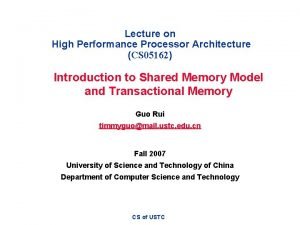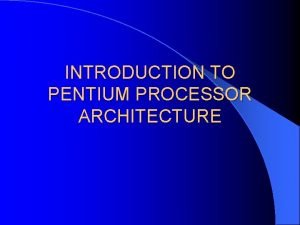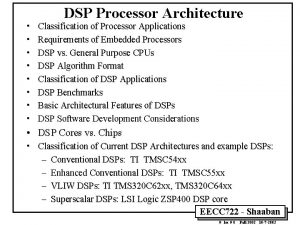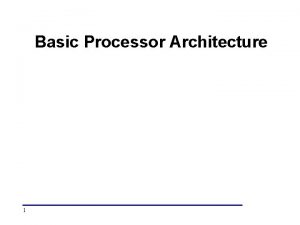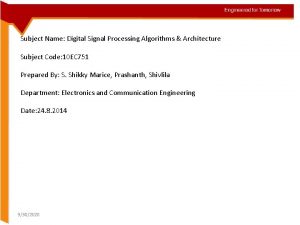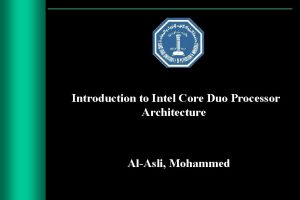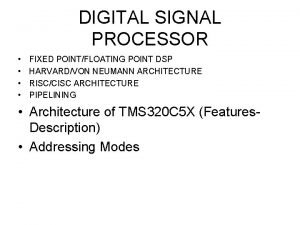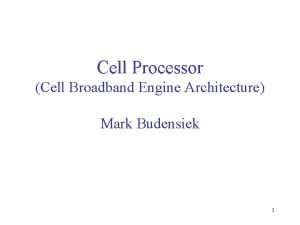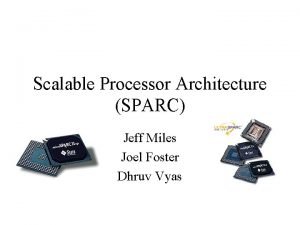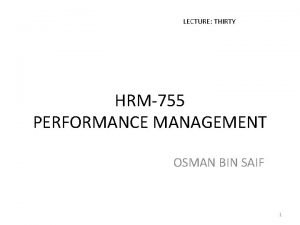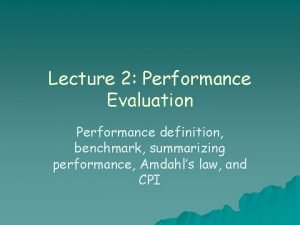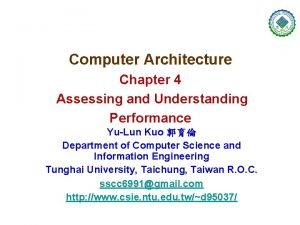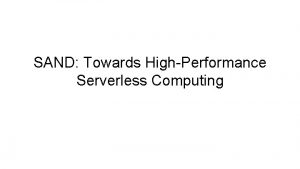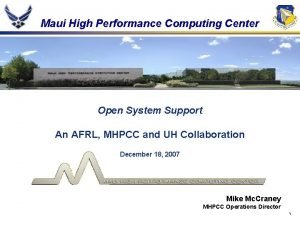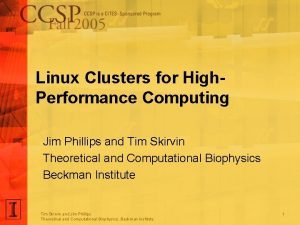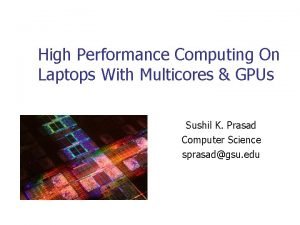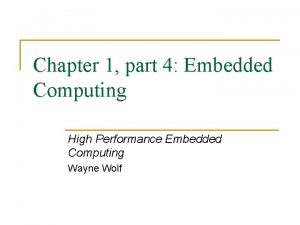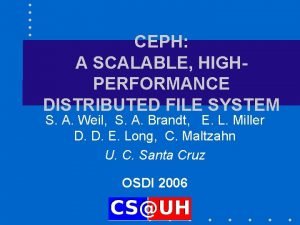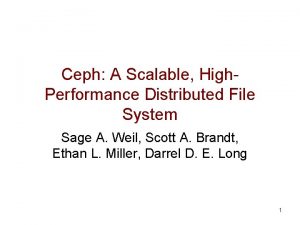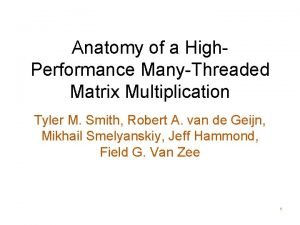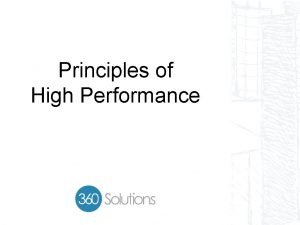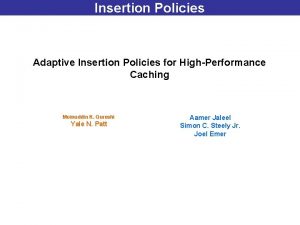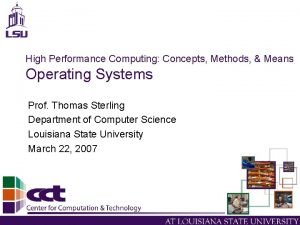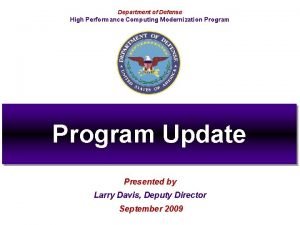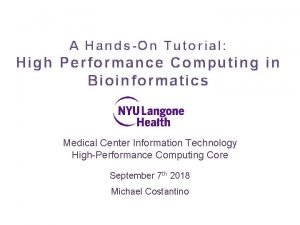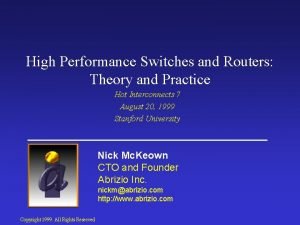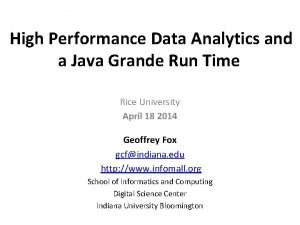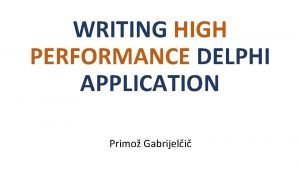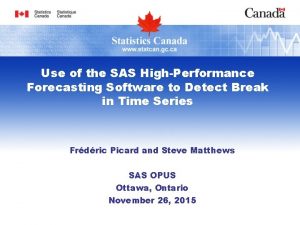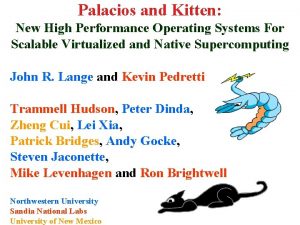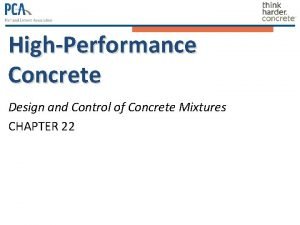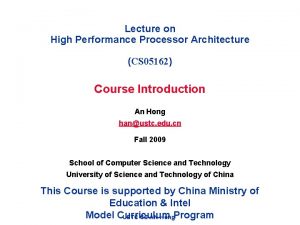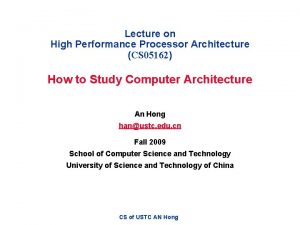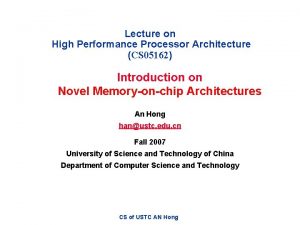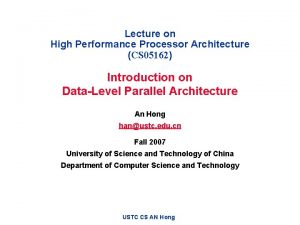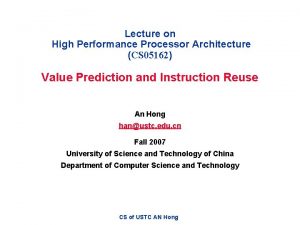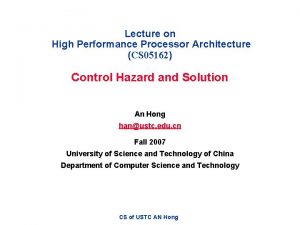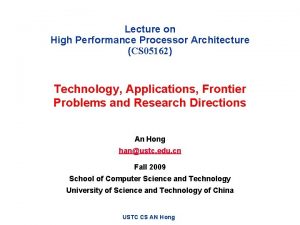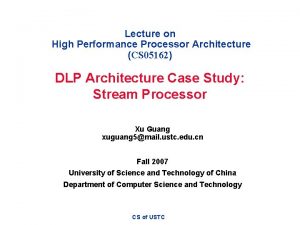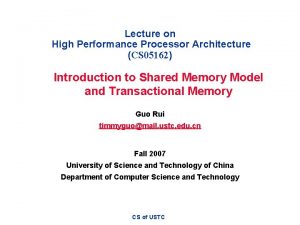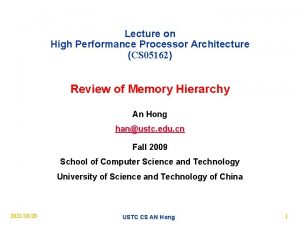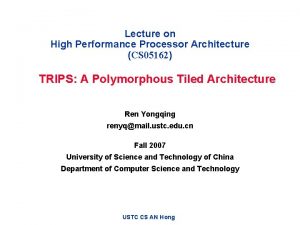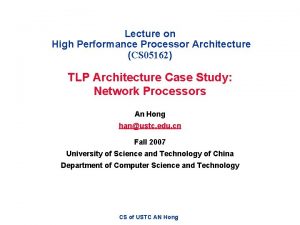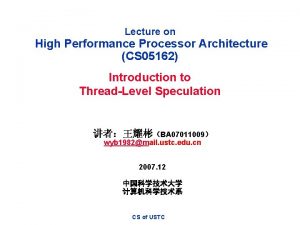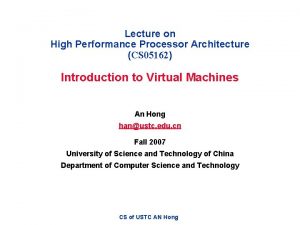Lecture on High Performance Processor Architecture CS 05162


















































- Slides: 50

Lecture on High Performance Processor Architecture (CS 05162) Review of Memory Hierarchy An Hong han@ustc. edu. cn Fall 2009 School of Computer Science and Technology University of Science and Technology of China 2021/9/25 USTC CS AN Hong 1

Quick review of everything you should have learned 2021/9/25 USTC CS AN Hong 2

Who Cares About the Memory Hierarchy? Processor-DRAM Memory Gap (latency) 1000 Moore’s Law 100 10 1 1980 1981 1982 1983 1984 1985 1986 1987 1988 1989 1990 1991 1992 1993 1994 1995 1996 1997 1998 1999 2000 Performance Proc 60%/yr. (2 X/1. 5 yr) Processor-Memory Performance Gap: (grows 50% / year) DRAM 9%/yr. (2 X/10 yrs) CPU 2021/9/25 Time USTC CS AN Hong 3

Levels of the Memory Hierarchy Upper Level Capacity Access Time Cost Staging Xfer Unit CPU Registers 100 s Bytes <10 s ns Registers Cache K Bytes 10 -100 ns 1 -0. 1 cents/bit Cache Instr. Operands Blocks Main Memory M Bytes 200 ns- 500 ns $. 0001 -. 00001 cents /bit Disk G Bytes, 10 ms (10, 000 ns) -5 -6 10 - 10 cents/bit Tape T Bytesor infinite sec-min 10 -8 cents/bit 2021/9/25 faster prog. /compiler 1 -8 bytes cache cntl 8 -128 bytes Memory Pages OS 512 -4 K bytes Files user/operator Mbytes Disk Tape USTC CS AN Hong Larger Lower Level 4

The Principle of Locality n The Principle of Locality: − Program access a relatively small portion of the address space at any instant of time. n Two Different Types of Locality: − Temporal Locality (Locality in Time): If an item is referenced, it will tend to be referenced again soon (e. g. , loops, reuse) − Spatial Locality (Locality in Space): If an item is referenced, items whose addresses are close by tend to be referenced soon (e. g. , straightline code, array access) n Last 20 years, HW relied on locality for speed and cost It is a property of programs which is exploited in machine design. 2021/9/25 USTC CS AN Hong 5

Memory Hierarchy: Terminology n Hit(命中): CPU访问存储系统时, 在高层找到所需的信息 (e. g. : Block X) − Hit Rate(命中率): CPU访问存储系统时, 在高层找到所需信息的概率 − Hit Time(命中时间): 在高层命中时的访问时间 RAM access time + Time to determine hit/miss n Miss(缺失): CPU访问存储系统时, 所需的信息 (e. g. : Block Y)需要从低层 传送到高层 − Miss Rate(缺失率) = 1 - (Hit Rate) − Miss Penalty(缺失开销): 在低层存储中找到一个信息块所需的时间 + 向高层传送一个信息块所需的时间 n Hit Time << Miss Penalty To Processor Upper Level Memory Lower Level Memory Blk X From Processor 2021/9/25 Blk Y USTC CS AN Hong 6

Cache Measures n Hit rate(命中率) − So high that usually talk about Miss rate − Miss rate fallacy: as MIPS to CPU performance, miss rate to average memory access time in memory n Miss penalty(缺失开销): time to replace a block from lower level, including time to replace in CPU − access time: 在低层存储中找到一个信息块所需的时间 = f(latency to access lower level) − transfer time: 向高层传送一个信息块所需的时间 =f(BW between upper & lower levels) n Average memory-access time(平均访问时间) = Hit time + Miss rate x Miss penalty (ns or clocks) 2021/9/25 USTC CS AN Hong 7

Four Questions for Memory Hierarchy Designers n Q 1: Where can a block be placed in the upper level? 块 的放置(Block placement) − Fully Associative, Set Associative, Direct Mapped n Q 2: How is a block found if it is in the upper level? 块的定位(Block identification) − Tag/Block n Q 3: Which block should be replaced on a miss? 块的替换(Block replacement) − Random, LRU n Q 4: What happens on a write? 写策略(Write strategy) − Write Through (with Write Buffer)(直写) or Write Back(回写) 2021/9/25 USTC CS AN Hong 8

Q 1: Where can a block be placed? n. Block 12 placed in 8 block cache: − Fully associative, direct mapped, 2 -way set associative − S. A. Mapping = Block Number Modulo Number Sets Direct mapped: block 12 can go only into block 4 (12 mod 8) Fully associative: block 12 can go anywhere Block no. 01234567 Set associative: block 12 can go anywhere in set 0 (12 mod 4) Block no. Set Set 0 1 2 3 Block-frame address Block no. 2021/9/25 01234567 111112222233 0123456789012345678901 USTC CS AN Hong 9


1 KB Direct Mapped Cache, 32 B blocks n For a 2 N byte cache: − The uppermost (32 - N) bits are always the Cache Tag − The lowest M bits are the Byte Select (Block Size = 2 31 Example: 0 x 50 ② Cache Tag Cache Data Byte 31 Byte 63 : : Valid Bit 0 x 50 : ① ③ Byte 1 Byte 0 0 Byte 33 Byte 32 1 2 3 : : Byte 1023 2021/9/25 ) 4 0 Byte Select Ex: 0 x 00 USTC CS AN Hong : Cache Tag 9 Cache Index Ex: 0 x 01 M Byte 992 31 11

Two-way Set Associative Cache n N-way set associative: N entries for each Cache Index − N direct mapped caches operates in parallel (N typically 2 to 4) n Example: Two-way set associative cache − Cache Index selects a set? from the cache − The two tags in the set are compared in parallel − Data is selected based on the tag result Valid Cache Tag : : Adr Tag Cache Index Cache Data Cache Block 0 ① : ② Compare ③ Sel 1 1 : ③ Mux 0 Sel 0 Cache Tag Valid : : ② Compare OR 2021/9/25 Hit Cache Block USTC CS AN Hong 12

N-way Set Associative Cache v. Direct Mapped Cache n 相联度越高, Cache空间的利用率就越高, 块冲突的概率越低, Cache 的缺 失率也就越低. 全相联的缺失率最低, 直接映射的缺失率最高 n 相联度越高, Cache 实现的复杂度和访问延迟就越大 n 大多数的处理器采用直接映射, 两路组相联, 或四路组相联 Valid Cache Tag : : Adr Tag Compare Cache Index Cache Data Cache Block 0 : : Sel 1 1 Mux 0 Sel 0 Cache Tag Valid : : Compare OR Hit 2021/9/25 Cache Block USTC CS AN Hong 13

Q 3: Which block should be replaced on a miss? n Easy for Direct Mapped n Set Associative or Fully Associative: − Random − LRU (Least Recently Used) Associativity: 2 -way 4 -way 8 -way Size LRU Random 16 KB 5. 2% 5. 7% 4. 7% 5. 3% 4. 4% 5. 0% 64 KB 1. 9% 2. 0% 1. 5% 1. 7% 1. 4% 1. 5% 256 KB 1. 15% 1. 17% 1. 13% 1. 12% 2021/9/25 USTC CS AN Hong 14

Q 4: What happens on a write? n Write through(WT, 直写): the information is written to both the block in the cache and to the block in the lowerlevel memory. − WT always combined with write buffers so that don’t wait for lower level memory n Write back(WB, 后写): the information is written only to the block in the cache. The modified cache block is written to main memory only when it is replaced. − is block clean or dirty? 2021/9/25 USTC CS AN Hong 15

Write Buffer for Write Through Processor Cache DRAM Write Buffer n A Write Buffer is needed between the Cache and Memory − Processor: writes data into the cache and the write buffer − Memory controller: write contents of the buffer to memory n Write buffer is just a FIFO: − Typical number of entries: 4 − Works fine if: Store frequency (w. r. t. time) << 1 / DRAM write cycle n Memory system designer’s nightmare: − Store frequency (w. r. t. time) -> 1 / DRAM write cycle − Write buffer saturation 2021/9/25 USTC CS AN Hong 16


Cache history n Caches introduced (commercially) more than 30 years ago in the IBM 360/85 − already a processor-memory gap n Oblivious to the ISA − caches were organization, not architecture n Many different organizations − direct-mapped, set-associative, skewed-associative, sector, decoupled sector etc. n Caches are ubiquitous − On-chip, off-chip − But also, disk caches, web caches, trace caches etc. n Multilevel cache hierarchy − With inclusion or exclusion − 4+ level 2021/9/25 USTC CS AN Hong 18

Cache history n Cache exposed to the ISA − Prefetch, Fence, Purge etc. n Cache exposed to the compiler − Code and data placement n Cache exposed to the O. S. − Page coloring n Many different write policies − copy-back, write-through, fetch-on-write, write-around, writeallocate etc. 2021/9/25 USTC CS AN Hong 19

Cache history n Numerous cache assists, for example: − For storage: write-buffers, victim caches, temporal/spatial caches − For overlap: lock-up free caches − For latency reduction: prefetch − For better cache utilization: bypass mechanisms, dynamic line sizes − etc. . . 2021/9/25 USTC CS AN Hong 20

Caches and Parallelism n Cache coherence − Directory schemes − Snoopy protocols n Synchronization − Test-and-test-and-set − load linked -- store conditional n Models of memory consistency − TCC, Log. TM 2021/9/25 USTC CS AN Hong 21

When were the 2 K papers being written? n A few facts: − 1980 textbook: < 10 pages on caches (2%) − 1996 textbook: > 120 pages on caches (20%) n Smith survey (1982) − About 40 references on caches n Uhlig and Mudge survey on trace-driven simulation (1997) − About 25 references specific to cache performance only − Many more on tools for performance etc. 2021/9/25 USTC CS AN Hong 22

Cache research vs. time Largest number (14) 1 st session on caches 2021/9/25 USTC CS AN Hong 23

Present Latency Solutions and Limitations Solution Larger Caches § Slow § Works well only if working set fits cache and there is temporal locality Hardware Prefetching § Cannot be tailored for each application § Behavior based on past and present execution-time behavior Software Prefetching § Ensure overheads of prefetching do not outweigh the benefits> conservative prefetching § Adaptive software prefetching is required to change prefetch distance during run-time § Hard to insert prefetches for irregular access patterns Multithreading 2021/9/25 § focus on solving the throughput problem, not the memory latency problem USTC CS AN Hong 24

The Memory Bandwidth Problem n It’s expensive! n Often ignored n Processor-centric optimization to bridge the gap but lead to memory-bandwidth problems − Prefetching − Speculation − Multithreading hide latency Can we always just trade bandwidth for latency? 2021/9/25 USTC CS AN Hong 25

Present Bandwidth Solutions n Wider/faster connections to memory − Rambus DRAM − Use higher signaling rates on existing pins − Use more pins for the memory interface n Larger on-chip caches − Fewer requests to DRAM − Only effective if larger caches improve hit rate n Traffic-efficient requests − Only request what you need − Caches are “guessing” that you might need adjacent data − Compression? 2021/9/25 USTC CS AN Hong 26

Present Bandwidth Solutions n More efficient on-chip caches − Only 1/20 – 1/3 of the data in a cache is live − Again, caches are “guessing” what will be used again − Spatial vs. temporal vs. no locality n Logic/DRAM integration − Put the memory on the processor − On-chip bandwidth is cheaper than pin bandwidth − You will still probably have external DRAM as well n Memory-centric architectures − “Smart” memory (PIM) − Put processing elements wherever there is memory 2021/9/25 USTC CS AN Hong 27

评测存储系统性能的指标 A. M. A. T : Average Memory Access time IC: Instruction Count CCT: Clock cycle time (1) 平均访存时间 A. M. A. T= (Hit Rate x Hit Time) +(Miss Rate x Miss Time ) = (Hit Rate x Hit Time) +(1–Hit Rate ) x (Hit Time + Miss Penalty) = Hit Time + (Miss Rate x Miss Penalty) (2) CPU性能公式(带存储器层次结构的CPU性能公式) 复习: 不考虑访存造成的CPU暂停周期时的CPU性能公式 CPU时间 = 执行一个程序所需的时钟周期数× 时钟周期 = IC ×CPI × Clock Cycle time 2021/9/25 USTC CS AN Hong 28

评测存储系统性能的指标 第一种扩展形式: CPU time = (CPU execution clock cycles + Memory stall clock cycles) x CCT Memory stall clock cycles = (Reads x Read miss rate x Read miss penalty + Writes x Write miss rate x Write miss penalty) = Memory accesses x Miss rate x Miss penalty 第二种扩展形式: CPU time = ICx (CPIexecution + Mem accesses per instruction x Miss rate x Miss penalty) x CCT = IC x (CPIexecution + Misses per instruction x Miss penalty) x CCT 2021/9/25 USTC CS AN Hong 29

Improving Cache Performance: 3 general options Average Memory Access time = Hit Time + (Miss Rate x Miss Penalty) = (Hit Rate x Hit Time) + (Miss Rate x Miss Time) 1. Reduce the miss rate, 2. Reduce the miss penalty, or 3. Reduce the time to hit in the cache. 2021/9/25 USTC CS AN Hong 30

A Modern Memory Hierarchy n By taking advantage of the principle of locality: − Present the user with as much memory as is available in the cheapest technology. − Provide access at the speed offered by the fastest technology. Processor Control Speed (ns): 1 s Size (bytes): 100 s 2021/9/25 On-Chip Cache Registers Datapath Second Level Cache (SRAM) Main Memory (DRAM) 10 s 100 s Ks Ms USTC CS AN Hong Tertiary Secondary Storage (Disk/Tape) (Disk) 10, 000 s 10, 000, 000 s (10 s ms) (10 s sec) Gs Ts 31

Recall: Levels of the Memory Hierarchy Upper Level Capacity Access Time Cost Staging Xfer Unit CPU Registers 100 s Bytes <10 s ns Registers Cache K Bytes 10 -100 ns $. 01 -. 001/bit Cache Instr. Operands Blocks Main Memory M Bytes 100 ns-1 us $. 01 -. 001 Disk G Bytes ms -4 -3 10 - 10 cents Tape infinite sec-min 10 -6 2021/9/25 faster prog. /compiler 1 -8 bytes cache cntl 8 -128 bytes Memory Pages OS 512 -4 K bytes Files user/operator Mbytes Disk Tape USTC CS AN Hong Larger Lower Level 32

How is the hierarchy managed? n Registers <-> Memory − by compiler (programmer? ) n Cache <-> Memory − by the hardware n Memory <-> Disks − by the hardware and operating system (virtual memory) − by the programmer (files) 2021/9/25 USTC CS AN Hong 33






分页 V. A. P. A. 0 1024 frame 0 1 1 K 1 K 7 7168 Addr Trans MAP 1 K Physical Memory 0 1024 2021/9/25 1 K 1 K also unit of transfer from virtual to physical 1 K memory Virtual Memory 10 disp page no. Page Table Base Reg index into page table 31 31744 Address Mapping VA page 0 1 unit of mapping Page Table V Access Rights PA table located in physical memory + actually, concatenation is more likely physical memory USTC address CS AN Hong 39

大地址空间 两级页表 1 K PTEs 32 -bit 地址: 10 P 1 index 10 P 2 index 4 KB 12 page offest 4 bytes ° 4 GB virtual address space 一级页表 ° 4 MB of PTE 2 ° 4 KB of PTE 1 What about a 48 -64 bit address space? 2021/9/25 4 bytes 二级页表 USTC CS AN Hong 40

Virtual Address and a Cache: Step backward? ? ? VA CPU miss PA Translation Cache Main Memory hit data n Virtual memory seems to be really slow: − we have to access memory on every access -- even cache hits! − Worse, if translation not completely in memory, may need to go to disk before hitting in cache! n Solution: Caching page table! − Keep track of most common translations and place them in a “Translation Lookaside Buffer” (TLB, 快表) 2021/9/25 USTC CS AN Hong 41

Making address translation practical: TLB n Translation Look-aside Buffer (TLB) is a cache of recent translations virtual address Virtual Address Space Physical Memory Space page off Page Table 2 0 在内存 1 3 TLB frame page 2 2 0 5 2021/9/25 USTC CS AN Hong physical address page off 在片内 42

TLB organization: include protection Virtual Address Physical Address Dirty Ref Valid Access ASID 0 x. FA 00 0 x 0041 0 x 0003 0 x 0010 0 x 0011 Y N N N Y Y Y R/W R R 34 0 0 n. TLB usually organized as fully-associative cache − Lookup is by Virtual Address − Returns Physical Address + other info n. Dirty => Page modified (Y/N)? Ref => Page touched (Y/N)? Valid => TLB entry valid (Y/N)? Access => Read? Write? ASID => Which User? 2021/9/25 USTC CS AN Hong 43


Reducing translation time further n As described, TLB lookup is in serial with cache lookup: Virtual Address 10 offset V page no. TLB Lookup V Access Rights PA P page no. offset 10 Physical Address n Machines with TLBs go one step further: they overlap TLB lookup with cache access. − Works because lower bits of result (offset) available early 2021/9/25 USTC CS AN Hong 45

Summary #1/5: Control and Pipelining n Control VIA State Machines and Microprogramming n Just overlap tasks; easy if tasks are independent n Speed Up Pipeline Depth; if ideal CPI is 1, then: n Hazards limit performance on computers: − Structural: need more HW resources − Data (RAW, WAR, WAW): need forwarding, compiler scheduling − Control: delayed branch, prediction 2021/9/25 USTC CS AN Hong 46

Summary #2/5: Caches n The Principle of Locality: − Program access a relatively small portion of the address space at any instant of time. l Temporal Locality: Locality in Time l Spatial Locality: Locality in Space n Three Major Categories of Cache Misses: − Compulsory Misses: sad facts of life. Example: cold start misses. − Capacity Misses: increase cache size − Conflict Misses: increase cache size and/or associativity. Nightmare Scenario: ping pong effect! n Write Policy: − Write Through: needs a write buffer. Nightmare: WB saturation − Write Back: control can be complex 2021/9/25 USTC CS AN Hong 47

Summary #3/5: The Cache Design Space n Several interacting dimensions Cache Size − cache size − block size − associativity − replacement policy − write-through vs write-back − write allocation Associativity Block Size n The optimal choice is a compromise − depends on access characteristics l workload l use (I-cache, D-cache, TLB) − depends on technology / cost n Simplicity often wins 2021/9/25 USTC CS AN Hong Bad Good Factor A Less Factor B More 48

Summary #4/5: TLB, Virtual Memory n Caches, TLBs, Virtual Memory all understood by examining how they deal with 4 questions: − 1) Where can block be placed? − 2) How is block found? − 3) What block is repalced on miss? − 4) How are writes handled? n Page tables map virtual address to physical address n TLBs are important for fast translation n TLB misses are significant in processor performance − funny times, as most systems can’t access all of 2 nd level cache without TLB misses! 2021/9/25 USTC CS AN Hong 49

Summary #5/5: Memory Hierachy n Virtual memory was controversial at the time: can SW automatically manage 64 KB across many programs? − 1000 X DRAM growth removed the controversy n Today VM allows many processes to share single memory without having to swap all processes to disk; today VM protection is more important than memory hierarchy n Today CPU time is a function of (ops, cache misses) vs. just f(ops): What does this mean to Compilers, Data structures, Algorithms? 2021/9/25 USTC CS AN Hong 50
 Principles of high-performance processor design
Principles of high-performance processor design 01:640:244 lecture notes - lecture 15: plat, idah, farad
01:640:244 lecture notes - lecture 15: plat, idah, farad Pentium processor architecture
Pentium processor architecture Dsp architecture block diagram
Dsp architecture block diagram Architecture building blocks examples
Architecture building blocks examples Dsp algorithms and architecture
Dsp algorithms and architecture Intel core processor architecture
Intel core processor architecture Digital signal processor architecture
Digital signal processor architecture Cell processor architecture
Cell processor architecture Scalable processor architecture
Scalable processor architecture Performance management lecture
Performance management lecture Lecture performance definition
Lecture performance definition Computer architecture notes
Computer architecture notes Isa definition computer
Isa definition computer Behaviorally anchored rating scales
Behaviorally anchored rating scales Behaviorally anchored rating scale
Behaviorally anchored rating scale Jcids process
Jcids process Computer architecture performance evaluation methods
Computer architecture performance evaluation methods Basic performance equation in computer organization
Basic performance equation in computer organization Cloud gaming architecture and performance
Cloud gaming architecture and performance Decruitment options
Decruitment options Sand: towards high-performance serverless computing
Sand: towards high-performance serverless computing Mhpcc
Mhpcc High performance computing linux
High performance computing linux High performance work practices examples
High performance work practices examples Application of chromatography
Application of chromatography Laptops for high performance computing
Laptops for high performance computing High performance nutrition
High performance nutrition High performance embedded computing
High performance embedded computing Ceph: a scalable, high-performance distributed file system
Ceph: a scalable, high-performance distributed file system Ceph: a scalable, high-performance distributed file system
Ceph: a scalable, high-performance distributed file system Anatomy of high-performance matrix multiplication
Anatomy of high-performance matrix multiplication High performance development model
High performance development model High performance organization principles
High performance organization principles Adaptive insertion policies for high performance caching
Adaptive insertion policies for high performance caching High performance development model
High performance development model High performance operating system
High performance operating system High performance sql server
High performance sql server High performance computing modernization program
High performance computing modernization program Big purple nyu
Big purple nyu High performance cycle theory
High performance cycle theory Ged high impact indicators
Ged high impact indicators What is hpda
What is hpda High performance web sites
High performance web sites High performance switches
High performance switches High performance data analytics definition
High performance data analytics definition Queryperformancecounter delphi
Queryperformancecounter delphi High-performance forecasting
High-performance forecasting High performance operating system
High performance operating system High performance concrete
High performance concrete Density of concrete
Density of concrete
